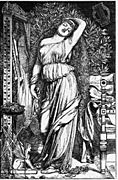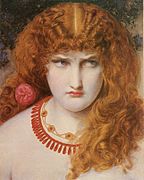Frederick Sandys facts for kids
Quick facts for kids
Frederick Sandys
|
|
|---|---|

Portrait of Frederick Sandys by his father Anthony Sand (1848)
|
|
| Born | 1 May 1829 Norwich, England
|
| Died | 25 June 1904 (aged 75) Kensington, London, England
|
| Nationality | British |
| Education | John Crome |
| Known for | Landscape painting |
| Movement | Norwich School of Design; Norwich School of painters |
Anthony Frederick Augustus Sandys (born Antonio Frederic Augustus Sands; May 1, 1829 – June 25, 1904), known as Frederick Sandys, was a British artist. He was a talented painter, illustrator, and draughtsman (someone skilled in drawing). He is often linked with the Pre-Raphaelites, a group of artists who wanted to return to the detailed art style before Raphael. He was also part of the Norwich School of painters.
Contents
Biography
Artistic Studies and Early Life
Frederick Sandys was born in Norwich. He learned art from his father, Anthony Sands, who was also a painter. Frederick showed a natural talent for drawing from a young age. He went to Norwich School and later studied at the Norwich School of Design in 1846. His artistic skills were recognized by the Royal Society of Arts in 1846 and 1847.
Family and Relationships
Sandys married Georgiana Creed, but their marriage lasted only three years. Later, he had children with Romany model Keomi Gray. Keomi also modeled for other famous artists like Dante Gabriel Rossetti.

In 1862, Sandys met actress Mary Emma Jones, also known as Miss Clive. She became a model for his painting The Magdalen. Sandys and Mary Emma Jones lived together for the rest of his life. They had many children together. Mary Emma Jones appeared in several of Sandys's paintings, including Love's Shadow and Proud Maisie. He made many versions of Proud Maisie because he was so inspired by her.
Sandys also influenced his younger sister, Emma Sandys (1841–1877). She became a painter known for her portraits of children and young women. Her subjects often wore old-fashioned or medieval clothes.
Frederick Sandys passed away in Kensington, west London, in 1904.
Works
Early Artworks
Sandys was very skilled at drawing. He became well-known for his print called The Nightmare (1857). This artwork was a parody, or a funny imitation, of another famous painting by John Everett Millais. In his parody, Sandys changed the horse into a laughing donkey. This print made people curious about the artist and helped Sandys become known in the London art world.
Sandys became good friends with Dante Gabriel Rossetti, another Pre-Raphaelite artist. They even lived together for a while. Rossetti's art greatly influenced Sandys's work. Sandys often painted scenes from myths and created many portraits.
Drawings and Illustrations

Wood-Engravings Many people first saw Pre-Raphaelite art in magazines like Once a Week and Cornhill Magazine. Sandys started drawing for these magazines in the 1860s. His work was inspired by artists like Albrecht Dürer. He created 26 wood-engravings between 1859 and 1866. These were carefully carved onto wood by skilled engravers like the Dalziel brothers.
For engravers to create detailed images, they needed very clear drawings from the artist. Sandys was excellent at drawing tiny details. He wanted his art to be very accurate. This skill made his wood-engravings impressive both for their technical detail and their imaginative ideas.
One example of his detailed drawings is The Death of King Warwulf. It shows swirling flames and the curve of a boat, creating a feeling of movement. The main focus is the king's bowed head.
-
Danaë in the Brazen Chamber, wood-engraving, signed by Swain, Museum of Fine Arts, Boston
Chalk Drawings of Famous Men Sandys also made many chalk drawings of well-known writers. These included Tennyson, Browning, Matthew Arnold, and James Russell Lowell.
Studies for Paintings Study for Vivien shows Sandys's model, Keomi Gray, as Vivien from Tennyson's poem Idylls of the King. Sandys often used stories from King Arthur as inspiration for his art, like King Pelles' Daughter. In this study, Vivien looks beautiful and confident.
Study for Autumn, made in 1860, is one of many drawings Sandys created before painting his final work Autumn. It shows his amazing skill as a draughtsman. He captured tiny details like the soldier's uniform and the plants. This study is very similar to the finished painting.
-
Study for Vivien, black and red chalk, Norwich Castle Museum and Art Gallery
-
Study for Autumn, 1860, Norwich Castle Museum and Art Gallery
-
Study for Spring, 1860, Norwich Castle Museum and Art Gallery
Paintings

In the early 1860s, Sandys began to show his paintings, which made him even more famous. Some of his best-known paintings include Vivien (1863), Morgan le Fay (1864), Cassandra, and Medea (1868).
Sandys was not a painter who tried to please everyone. He painted only a few works, but they were very powerful and often showed sad or serious themes. His art had a deep, almost serious beauty that made it stand out. Stories from the Scandinavian Sagas and Le Morte d'Arthur (tales of King Arthur) were perfect subjects for him. The Valkyrie and Morgan le Fay are considered some of his finest paintings.
-
Queen Eleanor, 1858, National Museum Cardiff
-
Morgan le Fay, 1864, Birmingham Museum & Art Gallery
-
Grace Rose, 1866, Yale Center for British Art
-
Helen of Troy, 1867, Walker Art Gallery
-
Medea, 1868, Birmingham Museum & Art Gallery
See also
- Emma Sandys – a painter and Frederick's sister
- List of Pre-Raphaelite paintings – includes works by Anthony Frederick Augustus Sandys.
















